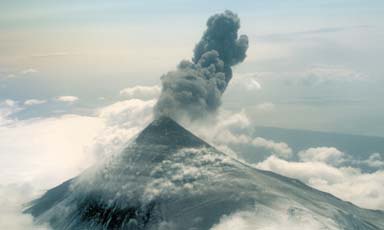AirPollution
Air Pollution, including dust
The effects of air pollution on coral reefs are getting more and more attention over the decades, as the serious threats caused by air pollution to world coral reefs are now widely recognized by scientists. It is important to understand how corals are in risks because of air pollution.
Source of Pollution

Generally, air pollution is any substance that people introduce into the atmosphere that has damaging effects on living things and the environment.
Both human activity and natural process can create air pollution.
There are various sources of human-related air pollution. Major sources include:
- industrial waste gas composed of smoke, sulfides, nitrides, organic compounds, halides, carbides, etc.
- vehicle exhaust composed of carbon monoxide, sulfur dioxide, nitric oxides, and hydrocarbon as a result of burning fuels
- other pollutants created in human’s daily life, such as CFCs, ozone, and so on.
Some natural processes are also responsible for the air pollution. One major source of natural air pollution is the volcanic activities, where tons of pollutants including carbon dioxide, sulfuric oxides, and macro-particles are ejected into the atmosphere by volcanoes. Wildfires, desertification and emission of methane by animals are also major sources of the pollutants.
Impacts of Pollution
How will the air pollution affect the coral reefs in the ocean?
- The fine airborne particles, or aerosols, can scatter incoming sunlight and create cloudier, more reflective conditions. [2]These macro-particles floating in the air can reduce the amount of sunlight reaching the sea surface in a large scale. And if the amount of aerosols is too large, the haze may form and block even more sunlight. As a result, the photosynthesis of the single-celled algae, zooxanthellae, which keeps a symbiotic relation with coral, will reduce sharply. Thus, the amount of nutrition the coral can obtain from zooxanthellae in order for its growth will reduce. As less sunlight reaches the sea, the water temperature will fall, worsening the situation even more. The growth rate of coral will be limited due to the insufficient sunlight and the cold water temperature. Coral bleaching, a process caused by the expulsion of zooxanthellae, will occur if the water gets too cold, possibly leaving the coral to death.
- Global warming is another big threat to coral reefs. The rapid buildup of greenhouse gases (GHGs) in the atmosphere during the past centuries has brought significant contribution to the climate change in the world. As the climate gets hotter, the rising water temperature of ocean will cause large scale of coral bleaching. Massive corals will die as a result of the change of climate. The increasingly frequent extreme weathers and disasters such as hurricanes and tropical storms due to the change of climate and rise of water temperature will bring direct physical damages to coral reefs. Rising sea level due to global warming will make the situation even worse.
- It is reported that, many serious coral diseases are also related to air pollution. Scientists have found that, many pathogens will travel with the aerosols and spread over the world. One example is the African dust traveled with wind from deserts in Africa. Every year, several hundred million tons of African dusts are transported across the Atlantic to the Caribbean, Central and South America. Pathogens like fungus Aspergillus sydowii, which causes the sea-fan diseases, and sphingomonas which is the cause of white plague.
- Air pollution is also responsible for ocean acidification. Ocean water normally contains carbonic acid because carbon dioxide in the atmosphere can be dissolved by the water. However, if the amount of carbon dioxide continues to increase, the chemistry of ocean water will be altered as the water contains more carbonic acid. As the water becomes more acidic, the amount of aragonite -- a mineral used by corals in reef building -- in the water will decrease and the ability of corals to build reefs by laying down their limestone skeletons will also be limited. Thus, the reversal of reef building will slow down and the loss of reef in the future may be a result.
References
Seminal article about African dust and the effects on Caribbean coral reefs. African dust can carry heavy metals, pesticides, fungi, and bacteria, and may contribute to coral disease:
Shinn, Eugene A., et al. "African dust and the demise of Caribbean coral reefs." Geophysical Research Letters 27.19 (2000): 3029-3032.
Dust documentary from USGS:
http://coastal.er.usgs.gov/african_dust/documentary.html
Maybe African dust doesn't carry the pathogens causing aspergillosis:
Krystal L. Rypien, Jason P. Andras and C. Drew Harvell. Globally panmictic population structure in the opportunistic fungal pathogen Aspergillus sydowii. Molecular Ecology (2008) 17, 4068–4078 doi: 10.1111/j.1365-294X.2008.03894.x
Burke L., Maidens J. Reefs at Risk in the Caribbean. World Resources Institute (2004).
The effects of aerosols on coral reef growth: Lester Kwiatkowski, Peter M. Cox, Theo Economou, Paul R. Halloran, Peter J. Mumby, Ben B. B. Booth, Jessica Carilli, et al. (2013). Caribbean coral growth influenced by anthropogenic aerosol emissions. Nature Geoscience. doi:10.1038/ngeo1780